The growth habit of the herbaceous horsetail Sphenophyllum
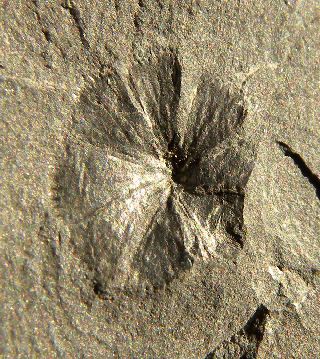 Sphenophyllum cuneifolium Ibbenbüren, Westfalian B. Height of the photo 3 cm. |
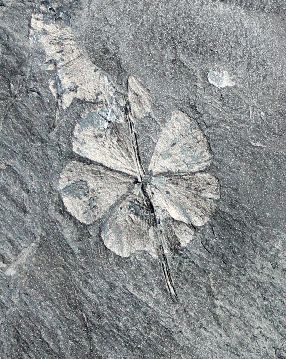 Sphenophyllum emarginatum. Piesberg, Westfalian D. Height of the photo 35 mm. |
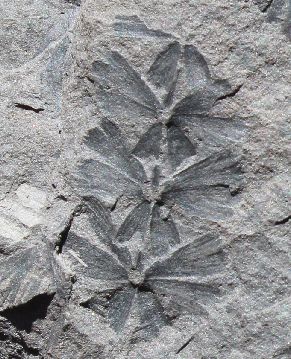 Sphenophyllum
oblongifolium.
Graissessac, Stephanian. Height of the photo 4 cm. |
However, many fossils of herbaceous horstetails are also found, of which the genus Sphenophyllum is the most common one. The leaflets of these plants are often wedge-shaped, which explains the name: sphen = wedge and phyllon = leaf. They are arranged in verticils at the nodes of the stems, like in Annularia and Asterophyllites. The number of the leaflets is mostly 6, verticils of 3 or 9 leaflets also occur. The stems are often somewhat thickened at the nodes.
The oldest species of Sphenophyllum
have been found in sediments of the Upper Devonian. Sphenophyllum is the most common during the Late Carboniferous and the Early Permian. In
the Late Permian still some species occur and at the end of this period
the genus gets extinct.
Many species of Sphenophyllum have been described, but here I restrict myself to the three species of which I have found enough specimens. They are S. cuneifolium and S.
emarginatum from the Westfalian (Piesberg and Ibbenbüren in Germany) and S. oblongifolium
from the Stephanian (Graissessac in France).
The three species (and most of the other ones as well) show about the same growth habit: they form long stems, which are branching
up to four times. It is striking that the often very long stems are
always relatively thin and that they hardly increase in thickness.
That's why it is assumed that the plants were leaning on other
vegetation or were covering the underground. There are also indications
that they were able to climb to some extent.
Striking
is also that the ultimate twigs in most cases have wedge-shaped
leaflets, whereas the leaflets of the lower branchings are mostly
linear. The ultimate twigs are by far the most common ones in the fossils.
All three species have mainly verticils of six leaflets. The leaflets often have a incision in the middle.
- S. emarginatum has leaflets of about the same size as the former species but they have blunt teeth whereas the notches in between are sharp. However, often the teeth are hardly visible or not and in that case the margin is nearly straight.
- S. oblongifolium has trizygoid leaf whorls. This means that such a verticil has two-sided symmetry with three pairs of leaflets of which one is directed downward.
Sphenophyllum
shows heterophylly. This means that one plant has different leaf-shapes. In the paper by Galtier & Daviero (1999)
on S. oblongifolium
from Graissessac there is a drawing of the several leaf-shapes
occurring on this plant. This picture is broadly also usable for S.
cuneifolium and S.
emarginatum
and for most of the other species in the genus. Only the shapes of the
leaflets on the ultimate twigs and the sizes are different.
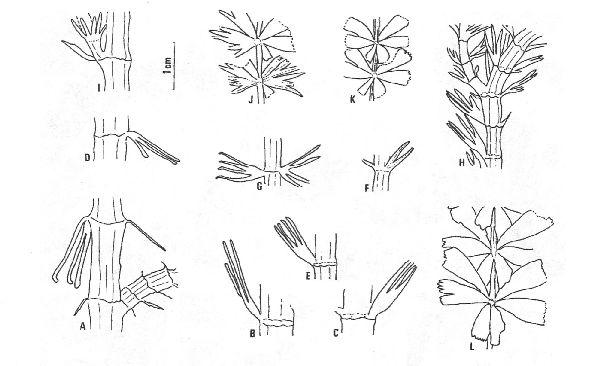 The different types of leaves in Sphenophyllum oblongifolium. A-D. Laciniate leaflets on a1axis. Sometimes reflexed. E-H. Also laciniate but shorter leaflets on a1 and a2 axes. I. Base of a branched a2 axis with a verticil of short leaflets. J. a3 axis with broader an less dissected leaflets. K-L. Ultimate twigs (a4) with typical tridygoid verticils. From Galtier & Daviero, 1999. With permission of Chicago Press. |
The lateral branches always come from a node, only one
at a time. Not from every node does a branch originate and there is no
regularity in the appearence of the branches. The length of the internodes
(the section between two nodes) differs also very much. However, the
first segment after a branching is usually very short. At the first node after a branching often a verticil with short leaflets is situated.
- The leaflets of the a2 axis are always deeply incised and they have a length of 5 – 10 mm. E-H.
At the base of an a2 axis a verticil of short leaflets can be present. I.
- a3-axes
have broader and less incised leaflets. J.
- a4-axes bear the typical trizygoid verticils of S.
oblongifolium. K- L.
This is also broadly applicable for S. cuneifolium and S. emarginatum but the ultimate twigs are different and the sizes are smaller.
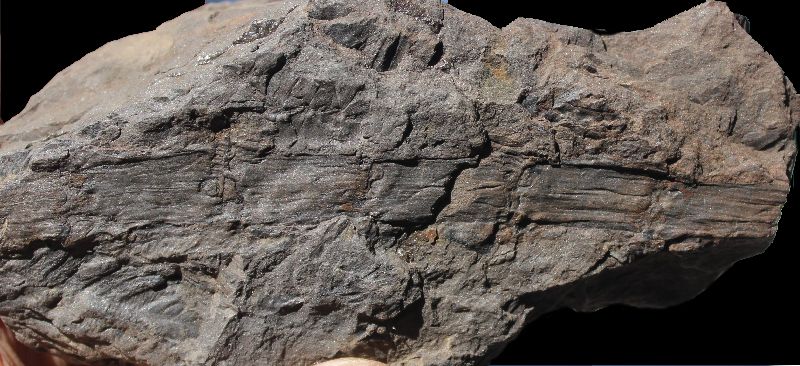 a1 axis of Sphenophyllum sp. Graissessac. Diameter of the axis 1 cm. |
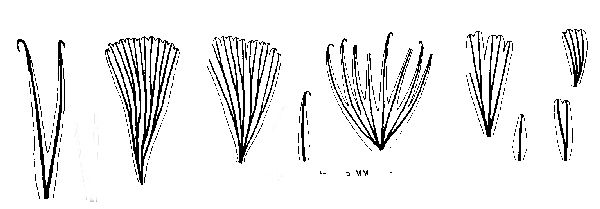 Leaf-shapes of Sphenophyllum emarginatum. The reflexed leaflets indicate a climbing function. After Batenburg, 1977. |
On S.
emarginatum
laciniate leaflets with reflexed tops have been found, which indicates
that this plant was not only leaning on other plants but that is was
able to climb. In my material I could not find these climbing hooks.
Galtier & Daviero (1999) did not find them either on S. oblongifolium,
but Barthel (1997) did describe them. The small hooks are not easily seen because they are often hidden in the sediment.
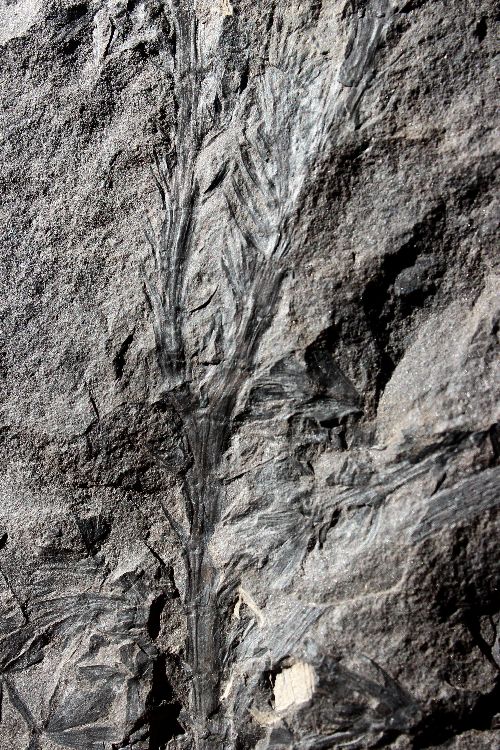 a1 and a2 axis of Sphenophyllum
oblongifolium with the characteristic laciniate leaflets.
Graissessac. Height of the photo 10 cm.
|
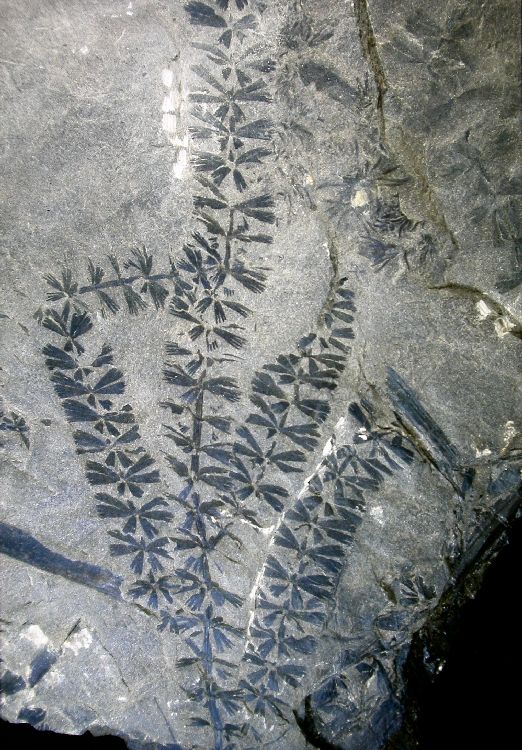 a3 axis with side twigs (a4 axes) of Sphenophyllum
oblongifolium. Graissessac. Height of the photo
25 cm.
Foto H. Kerp. Photo with polarized light.
|
The left hand picture is an example of an a1 axis of S.
oblongifolium with side twigs which are therefor a2 axes. The laciniate leaflets with linear lobes are typical for these axes.
The right hand picture shows an a3 axis of S. oblongifolium
with side twigs which are therefor a4 axes. The verticils of the
ultimate twigs are trizygoid whereas the leaflets of the a2 axes are
incised a bit deeper, but not as deep as in the left picture.
The spore cones of Sphenophyllum
are not very common. In fact Galtier & Daviero (1999) wrote that
they had found only a couple of not attached cones in their very
extensive collection. The same holds good in my collection. In the picture
on the left below spore cones can be seen in company of twigs of S. oblongifolium.
It can be assumed that they are from the same plant.
In the Piesberg finds of spore cones are also rather rare. The picture on the right shows a couple of cones of Sphenophyllum sp. attached to a twig with leaflets.
The growth habit of Sphenophyllum
Sphenophyllum
was probably a scrambling, leaning, creeping plant. It could be a
ground covering plant. The thick masses of stems and leaves of one species,
as they are often found, are an indication in this direction. On
the other hand it is very probable that the plant raised itself from
the ground by scrambling over other vegetation and its own species.
That it was able to climb is shown by the reflexed leaflets as they
have been found in e.g. S. emarginatum, but also in the other two species. The habit of Sphenophyllum is probably comparable with the one of the modern goose-grass.
The
fact that the verticils are mostly lying in het same plane with the
axes is an adaptation with the purpose to catch as much light as
possible while growing over other vegetation or as ground cover.
The
heterophylly can be an adaptation to this growth habit: the narrow
leaflets on the lower axes are helpful in leaning and scrambling.
whereas the wider leaflets of the ultimate twigs take care for
the photoanalysis.
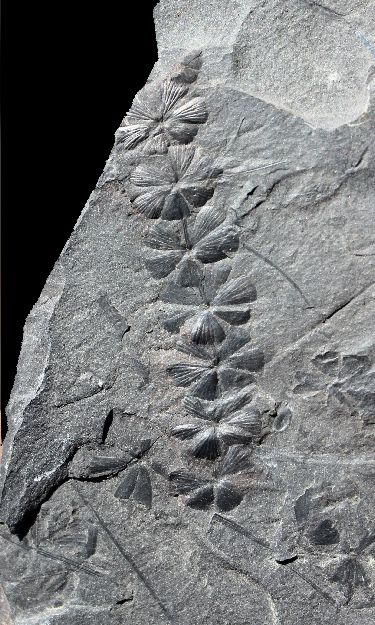
Ultimate twig of Sphenophyllum
emarginatum.
Piesberg. Height of the photo 8 cm.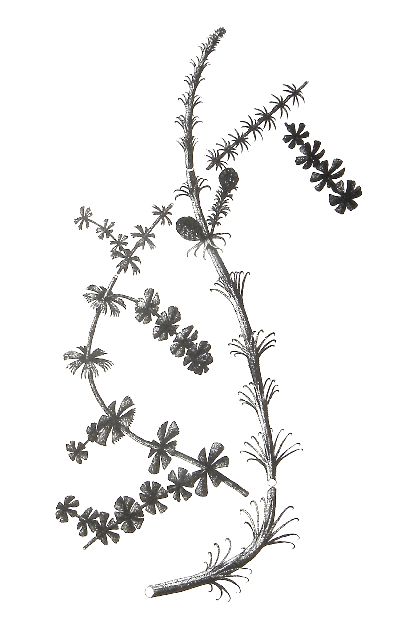
Reconstruction of Sphenophyllum
emarginatum.
From Cleal &
Thomas, 1994, after Batenburg, 1977.
With permission of The Palaeontological
Association.
Barthel
M.
1997 –
Epidermal Structures of Sphenophylls. Rev. Palaeobot. Palynol. 95: pp.
115-127.
Batenburg
L., 1977. The Sphenophyllum species in the
Carboniferous flora of Holz (Westphalian D, Saar Basin, Germany). Rev.
Palaeob.
Pal. 24: pp. 69-99.
Batenburg
L., 1981. Contributions
to the knowledge of Sphenophyllum.
Dissertation, RU Utrecht,. Van der Ley, Groningen.
Galtier
J.,
Daviero
V., 1999. Structure and Development of Sphenophyllum
oblongifolium from the Upper Carboniferous of France. Int. J. Plant
Sci, 160(5), pp. 1021-1033.
Cleal
C.J.,
Thomas B.A.,
1994. Plant fossils of the British Coal Measures. The Palaeontological
Association, London.
Taylor
T.N., Taylor E.L., Krings M., 2009. Paleobotany: The Biology and Evolution of Foaail Plants [2nd
Ed]. New York: Academic Press.